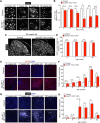Calpain-Dependent Degradation of Nucleoporins Contributes to Motor Neuron Death in a Mouse Model of Chronic Excitotoxicity
- PMID: 28821644
- PMCID: PMC6596668
- DOI: 10.1523/JNEUROSCI.0730-17.2017
Calpain-Dependent Degradation of Nucleoporins Contributes to Motor Neuron Death in a Mouse Model of Chronic Excitotoxicity
Abstract
Glutamate-mediated excitotoxicity induces neuronal death by altering various intracellular signaling pathways and is implicated as a common pathogenic pathway in many neurodegenerative diseases. In the case of motor neuron disease, there is significant evidence to suggest that the overactivation of AMPA receptors due to deficiencies in the expression and function of glial glutamate transporters GLT1 and GLAST plays an important role in the mechanisms of neuronal death. However, a causal role for glial glutamate transporter dysfunction in motor neuron death remains unknown. Here, we developed a new animal model of excitotoxicity by conditionally deleting astroglial glutamate transporters GLT1 and GLAST in the spinal cords of mice (GLAST+/-/GLT1-cKO). GLAST+/-/GLT1-cKO mice (both sexes) exhibited nuclear irregularity and calpain-mediated degradation of nuclear pore complexes (NPCs), which are responsible for nucleocytoplasmic transport. These abnormalities were associated with progressive motor neuron loss, severe paralysis, and shortened lifespan. The nuclear export inhibitor KPT-350 slowed but did not prevent motor neuron death, whereas long-term treatment of the AMPA receptor antagonist perampanel and the calpain inhibitor SNJ-1945 had more persistent beneficial effects. Thus, NPC degradation contributes to AMPA receptor-mediated excitotoxic motor neuronal death, and preventing NPC degradation has robust protective effects. Normalization of NPC function could be a novel therapeutic strategy for neurodegenerative disorders in which AMPA receptor-mediated excitotoxicity is a contributory factor.SIGNIFICANCE STATEMENT Despite glial glutamate transporter dysfunction leading to excitotoxicity has been documented in many neurological diseases, it remains unclear whether its dysfunction is a primary cause or secondary outcome of neuronal death at disease state. Here we show the combined loss of glial glutamate transporters GLT1 and GLAST in spinal cord caused motor neuronal death and hindlimb paralysis. Further, our novel mutant exhibits the nuclear irregularities and calpain-mediated progressive nuclear pore complex degradation. Our study reveals that glial glutamate transporter dysfunction is sufficient to cause motor neuronal death in vivo.
Keywords: animal model; excitotoxicity; glutamate; motor neuron; transporter.
Copyright © 2017 the authors 0270-6474/17/378831-15$15.00/0.
Figures








Similar articles
-
Loss of the astrocyte glutamate transporter GLT1 modifies disease in SOD1(G93A) mice.Exp Neurol. 2006 Sep;201(1):120-30. doi: 10.1016/j.expneurol.2006.03.028. Epub 2006 Jun 6. Exp Neurol. 2006. PMID: 16753145
-
Spinal cord-specific deletion of the glutamate transporter GLT1 causes motor neuron death in mice.Biochem Biophys Res Commun. 2018 Mar 4;497(2):689-693. doi: 10.1016/j.bbrc.2018.02.132. Epub 2018 Feb 16. Biochem Biophys Res Commun. 2018. PMID: 29458024
-
MFN2 couples glutamate excitotoxicity and mitochondrial dysfunction in motor neurons.J Biol Chem. 2015 Jan 2;290(1):168-82. doi: 10.1074/jbc.M114.617167. Epub 2014 Nov 21. J Biol Chem. 2015. PMID: 25416777 Free PMC article.
-
Late appearance of glutamate transporter defects in a murine model of ALS-parkinsonism dementia complex.Neurochem Int. 2007 Jun;50(7-8):1067-77. doi: 10.1016/j.neuint.2006.09.017. Epub 2006 Nov 13. Neurochem Int. 2007. PMID: 17095122 Review.
-
The role of excitotoxicity in the pathogenesis of amyotrophic lateral sclerosis.Biochim Biophys Acta. 2006 Nov-Dec;1762(11-12):1068-82. doi: 10.1016/j.bbadis.2006.05.002. Epub 2006 May 17. Biochim Biophys Acta. 2006. PMID: 16806844 Review.
Cited by
-
Potential Alzheimer's Disease Therapeutics Among Weak Cysteine Protease Inhibitors Exhibit Mechanistic Differences Regarding Extent of Cathepsin B Up-Regulation and Ability to Block Calpain.Eur Sci J. 2017 Oct;13:38-59. doi: 10.19044/esj.2017.c1p5. Eur Sci J. 2017. PMID: 29805718 Free PMC article.
-
Acute Cerebellar Inflammation and Related Ataxia: Mechanisms and Pathophysiology.Brain Sci. 2022 Mar 10;12(3):367. doi: 10.3390/brainsci12030367. Brain Sci. 2022. PMID: 35326323 Free PMC article. Review.
-
Brief and Diverse Excitotoxic Insults Increase the Neuronal Nuclear Membrane Permeability in the Neonatal Brain, Resulting in Neuronal Dysfunction and Cell Death.J Neurosci. 2024 Oct 9;44(41):e0350242024. doi: 10.1523/JNEUROSCI.0350-24.2024. J Neurosci. 2024. PMID: 39214703 Free PMC article.
-
Nuclear expansion and pore opening are instant signs of neuronal hypoxia and can identify poorly fixed brains.Sci Rep. 2018 Oct 3;8(1):14770. doi: 10.1038/s41598-018-32878-1. Sci Rep. 2018. PMID: 30282977 Free PMC article.
-
Neuroinflammation as the Underlying Mechanism of Postoperative Cognitive Dysfunction and Therapeutic Strategies.Front Cell Neurosci. 2022 Mar 28;16:843069. doi: 10.3389/fncel.2022.843069. eCollection 2022. Front Cell Neurosci. 2022. PMID: 35418837 Free PMC article. Review.
References
-
- Aida T, Yoshida J, Nomura M, Tanimura A, Iino Y, Soma M, Bai N, Ito Y, Cui W, Aizawa H, Yanagisawa M, Nagai T, Takata N, Tanaka KF, Takayanagi R, Kano M, Götz M, Hirase H, Tanaka K (2015) Astroglial glutamate transporter deficiency increases synaptic excitability and leads to pathological repetitive behaviors in mice. Neuropsycopharmacology 40:1569–1579. 10.1038/npp.2015.26 - DOI - PMC - PubMed
Publication types
MeSH terms
Substances
LinkOut - more resources
Full Text Sources
Other Literature Sources
Medical
Molecular Biology Databases
